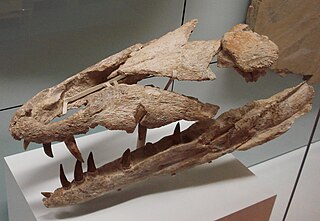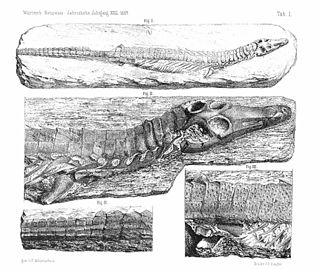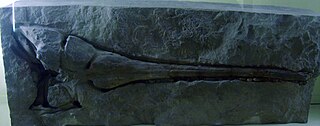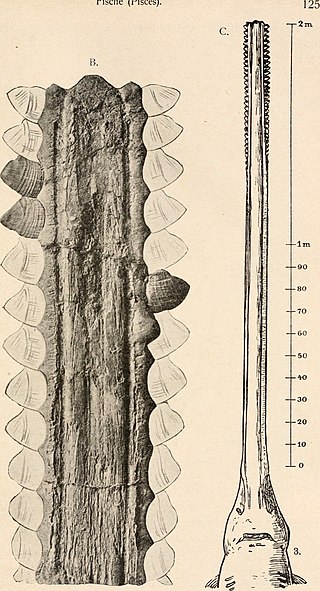
Dakosaurus is an extinct genus of crocodylomorph within the family Metriorhynchidae that lived during the Late Jurassic and Early Cretaceous. It was large, with teeth that were serrated and compressed lateromedially. The genus was established by Friedrich August von Quenstedt in 1856 for an isolated tooth named Geosaurus maximus by Theodor Plieninger in 1846. Dakosaurus was a carnivore that spent much, if not all, its life out at sea. The extent of its adaptation to a marine lifestyle means that it is most likely that it mated at sea, but since no eggs or nests have been discovered that have been referred to Dakosaurus, whether it gave birth to live young at sea like dolphins and ichthyosaurs or came ashore like turtles is not known yet. The name Dakosaurus means "biter lizard", and is derived from the Greek dakos ("biter") and σαῦρος -sauros ("lizard").

Termatosaurus is a potentially dubious genus of archosaur known from several tooth specimens. Its remains come from the Upper Triassic of France, England, Germany and Switzerland. Termatosaurus was once thought to have survived until the Early Jurassic, but the attributed Jurassic remains were redescribed as plesiosaur material. Two species are known of this animal: the type species, T. albertii, named by Meyer and T. Plieninger in 1844, and T. crocodilinus, by Quenstedt (1858).

Geosaurus is an extinct genus of marine crocodyliform within the family Metriorhynchidae, that lived during the Late Jurassic and the Early Cretaceous. Geosaurus was a carnivore that spent much, if not all, its life out at sea. No Geosaurus eggs or nests have been discovered, so little is known of the reptile's lifecycle, unlike other large marine reptiles of the Mesozoic, such as plesiosaurs or ichthyosaurs which are known to give birth to live young out at sea. Where Geosaurus mated, whether on land or at sea, is currently unknown. The name Geosaurus means "Mother of Giants lizard", and is derived from the Greek Ge- and σαῦρος -sauros ("lizard"). The name Geosaurus was established by the French naturalist Georges Cuvier in 1824.

Pelagosaurus is an extinct genus of thalattosuchian crocodyliform that lived during the Toarcian stage of the Lower Jurassic, around 183 Ma to 176 Ma, in shallow epicontinental seas that covered much of what is now Western Europe. The systematic taxonomy of Pelagosaurus has been fiercely disputed over the years, and was assigned to Thalattosuchia after its systematics within Teleosauridae were disputed. Pelagosaurus measured 2–3 m (6.6–9.8 ft) long.
Paleontology or palaeontology is the study of prehistoric life forms on Earth through the examination of plant and animal fossils. This includes the study of body fossils, tracks (ichnites), burrows, cast-off parts, fossilised feces (coprolites), palynomorphs and chemical residues. Because humans have encountered fossils for millennia, paleontology has a long history both before and after becoming formalized as a science. This article records significant discoveries and events related to paleontology that occurred or were published in the year 1997.

Diplocynodon is an extinct genus of alligatoroid crocodilian that lived during the Paleocene to Middle Miocene in Europe. Some species may have reached lengths of 3 metres (9.8 ft), while others probably did not exceed 1 metre (3.3 ft). They are almost exclusively found in freshwater environments. The various species are thought to have been opportunistic aquatic predators.

Cricosaurus is an extinct genus of marine crocodyliforms of the Late Jurassic. belonging to the family Metriorhynchidae. The genus was established by Johann Andreas Wagner in 1858 for three skulls from the Tithonian of Germany. The name Cricosaurus means "Ring lizard", and is derived from the Greek Krikos- ("ring") and σαῦρος -sauros ("lizard"). It was a relatively small reptile, with C. suevicus and C. araucanensis measuring 2 m (6.6 ft) and 3.2 m (10 ft) in total body length, respectively.

Platysuchus is an extinct genus of teleosaurid crocodyliform from the Early Jurassic (Toarcian) of southern Germany and Luxembourg.
Chrysochampsa is an extinct monospecific genus of alligatorine. Fossils have been found from the Golden Valley Formation of North Dakota and date back to the Wasatchian regional North American faunal stage of the early Eocene. The genus has been proposed to be synonymous with Allognathosuchus at times, but it is now generally accepted that Chrysochampsa is distinct from all other alligatoroids and is its own taxon.

Dyoplax is an extinct genus of pseudosuchian archosaur, possibly an erpetosuchid. Fossils have been found from the type locality within the upper Schilfsandstein Formation in Stuttgart, Germany. The holotype specimen was a natural cast of a nearly complete skeleton that lacked only parts of the tail and limb bones.
Eopneumatosuchus is an extinct genus of basal crocodyliform. Fossils have been found from two localities within the Kayenta Formation of Arizona. Both localities are around 20 miles southeast of the Grand Canyon and in close proximity to one another. The localities probably date back to the Early Jurassic, most likely during the Sinemurian stage.

Cylindracanthus is an extinct, enigmatic genus of marine ray-finned fish with fossils known throughout North America, Europe, Asia and Africa from the Late Cretaceous to the late Eocene, with potential Oligocene records and a possible Miocene record also known. It is exclusively known from its distinctive partial remains, which are long cylindrical bony spines that are usually considered rostrum fragments, as well as some associated teeth. These spines are abundant & widespread throughout this timespan, and are useful indicators of a nearshore marine environment, but the taxonomic identity of the fish is still highly uncertain and debated.
Orthogenysuchus is an extinct genus of caimanine alligatorids. Fossils have been found from the Wasatch Beds of the Willwood Formation of Wyoming, deposited during the early Eocene. The type species is O. olseni. The holotype, known as AMNH 5178, is the only known specimen belonging to the genus and consists of a skull lacking the lower jaws. The braincase is filled in by the matrix and most of the suture lines between bones are indiscernible, making comparisons with other eusuchian material difficult.

Pholidosaurus is an extinct genus of neosuchian crocodylomorph. It is the type genus of the family Pholidosauridae. Fossils have been found in northwestern Germany. The genus is known to have existed during the Berriasian-Albian stages of the Early Cretaceous. Fossil material found from the Annero and Jydegård Formations in Skåne, Sweden and on the island of Bornholm, Denmark, have been referred to as a mesoeucrocodylian, and possibly represent the genus Pholidosaurus.

Pristigenys is a genus of marine ray-finned fish in the family Priacanthidae. It contains five extant species and one extinct species, P. substriata, which is known from fossils found in the Eocene of Monte Bolca, Italy.

The Sachrang Formation or "Posidonienschiefer" Formation is a geological formation of southwestern Germany, northern Switzerland, northwestern Austria, southeast Luxembourg and the Netherlands, that spans about 3 million years during the Early Jurassic period. It is known for its detailed fossils, especially sea fauna, listed below. Composed mostly by black shale, the formation is a Lagerstätte, where fossils show exceptional preservation, with a thickness that varies from about 1 m to about 40 m on the Rhine level, being on the main quarry at Holzmaden between 5 and 14 m. Some of the preserved material has been transformed into fossil hydrocarbon Jet, specially wood remains, used for jewelry. The exceptional preservation seen on the Posidonia Shale has been studied since the late 1800s, finding that a cocktail of chemical and environmental factors let to such an impressive conservation of the marine fauna. The most common theory is the changes in the oxygen level, where the different anoxic events of the Toarcian left oxygen-depleted bottom waters, with the biota dying and falling to the bottom without any predator able to eat the dead bodies.
The Besano Formation is a geological formation in the southern Alps of northwestern Italy and southern Switzerland. This formation, a thin but fossiliferous succession of dolomite and black shale, is famous for its preservation of Middle Triassic (Anisian–Ladinian) marine life including fish and aquatic reptiles. It is exposed in the Monte San Giorgio and Besano area. It is among the formations responsible for the area being designated as a UNESCO World Heritage Site. In Switzerland, it is also known as the Grenzbitumenzone. The Anisian-Ladinian boundary lies in the upper part of the Besano Formation.
Microcnemus is an extinct genus of lizard-like early archosauromorph reptiles from the Protorosauridae. Members of the genus lived during the Early Triassic period in Russia. Once believed to have been an ancestor to lizards, Microcnemus is now known to be one of the oldest members of the lineage that would eventually lead to archosaurs such as crocodilians and dinosaurs. The type species, M. efremovi, was named in 1940 by the German palaeontologist Friedrich von Huene.

Propristis is an extinct genus of sawfish that lived from the Eocene to the Miocene. It contains two valid species, P. schweinfurthi and P. mayumbensis. It has been found in Egypt, Cabinda, Morocco, Qatar, Spain, the United Kingdom, and the United States. Isolated rostral denticles are the most common remains, but rostra have also been found.
This is an overview of the paleofauna of the Eocene Messel Formation as explored by the Messel Pit excavations in Germany. A former quarry and now UNESCO World Heritage Site, the Messel Formation preserves what once were a series of anoxic lakes surrounded by a sub-tropical rainforest during the Middle Eocene, approximately 47 Ma.












